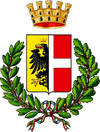Fidenza
| Fidenza | ||
|---|---|---|
| Comune | ||
| Città di Fidenza | ||
|
Town Hall and Garibaldi Obelisk | ||
| ||
 Fidenza Location of Fidenza in Italy | ||
| Coordinates: 44°52′N 10°04′E / 44.867°N 10.067°E | ||
| Country | Italy | |
| Region | Emilia-Romagna | |
| Province | Parma (PR) | |
| Frazioni | Bastelli, Cabriolo, Castione Marchesi, Chiusa Ferranda, Chiusa Viarola, Cogolonchio, Fornio, Monfestone, Osteria Pietralunga, Parola, Pieve Cusignano, Ponte Ghiara, Rimale, San Faustino, Santa Margherita, Siccomonte | |
| Government | ||
| • Mayor | Mario Cantini | |
| Area | ||
| • Total | 95 km2 (37 sq mi) | |
| Elevation | 75 m (246 ft) | |
| Population (30-04-2012) | ||
| • Total | 26,468 | |
| • Density | 280/km2 (720/sq mi) | |
| Demonym(s) | Fidentini or Borghigiani | |
| Time zone | CET (UTC+1) | |
| • Summer (DST) | CEST (UTC+2) | |
| Postal code | 43036 | |
| Dialing code | 0524 | |
| Patron saint | St. Domninus of Fidenza | |
| Saint day | October 9 | |
| Website | Official website | |
Fidenza is a town and comune in the province of Parma, Emilia-Romagna region, Italy. It has around 24,000 inhabitants. The town was renamed Fidenza in 1927, recalling its Roman name of Fidentia; before, it was called Borgo San Donnino.
History
The town originates from a Roman camp (Fidentia) founded on the place where the Gauls Anani had their settlement of Vicumvia. In 41 BC, it received the Roman citizenship and became a municipium.
In the 5th century, it was destroyed by Constantine I. From 1092 to 1100, Borgo San Donnino was the seat of King Conrad II of Italy. In the same year, it became a commune, confirmed in 1162 by Emperor Frederick Barbarossa, who entrusted it to the Pallavicino family of Piacenza. In 1199, it was conquered by Parma, but was freed in 1221 by Frederick II of Hohenstaufen. In 1268 the city was however destroyed by the troops of Parma. It was rebuilt around 1300; from 1346 to 1447, it was under a discontinuous lordship of the Visconti of Milan. In 1449, it was conquered by the new Milanese lords, the Sforza, who held it until 1499.
After the date, it continued to change move to an autonomous state to the subjection to Parma until 1556, when it became part of the Farnese duchy of Parma and Piacenza. After a period under France during the Napoleonic Wars, it was annexed to the Kingdom of Sardinia-Piedmont in 1859, during the unification of Italy.
The city underwent a large program of expansion during the Fascist government of Italy. It changed its name from Borgo Donnino to Fidenza in 1927. In May 1944, the city was bombed by Allied planes and nearly destroyed. In the Spring 1945, the German occupation troops perpetrated several massacres, such as that of the Carzole and of Via Baracc. It was conquered by the Allies on 26 April 1945.
Main sights
Fidenza's most famous building is the Cathedral, which dates from the 12th century and is dedicated to Domninus of Fidenza, who was martyred by order of Maximian in 304 AD. The town's previous name, Borgo San Donnino, was given in honor of the saint.[1]
The cathedral is an example of Lombard-Romanesque churches of the 11th to 13th centuries in northern Italy. The upper part of the façade is incomplete, but the lower, with its three portals and sculptures, is a fine example of Romanesque architecture, including two statues by Benedetto Antelami and bas-reliefs depicting the Histories of St. Domninus. The interior is simple and well-proportioned, and has not been spoilt by restoration. The statue at the front of the cathedral of the apostle Simon Peter is famous for its pointing in the direction of Rome, held in the left hand is an inscription reading "I show you the way to Rome", making it one of the world's first road signs.
Enrichetta d'Este, Duchess of Parma is buried here.
The Palazzo Comunale is also medieval, being first mentioned in 1191. The current structure dates from the 14th century but has a new façade which was added in the 19th century. After being destroyed by Spanish and French troops during the Italian Wars, it was rebuilt and enlarged.
Remains of the medieval town are visible near the cathedral, include the only surviving gate, the Porta San Donnino. It was built by the Visconti family in 1364.
Twin towns
References
- ↑
 Chisholm, Hugh, ed. (1911). "Borgo San Donnino". Encyclopædia Britannica 4 (11th ed.). Cambridge University Press. p. 250.
Chisholm, Hugh, ed. (1911). "Borgo San Donnino". Encyclopædia Britannica 4 (11th ed.). Cambridge University Press. p. 250.
